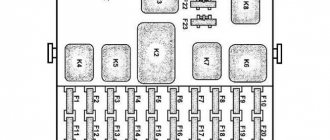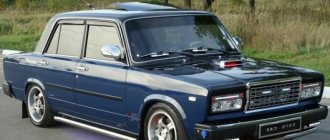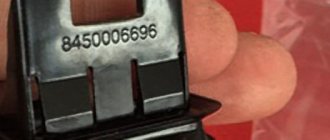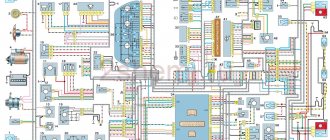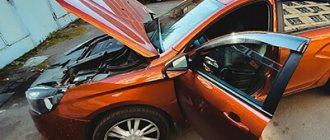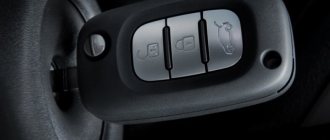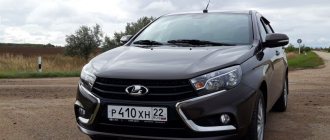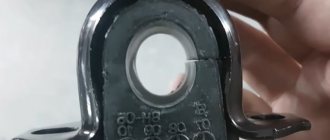Mounting block
Lada Vesta fuse diagram
Interior mounting block
Schematic location of fuses
Body connector
Layout of buttons on the steering wheel
Lada Vesta is equipped with many electrical appliances, each of which is vulnerable to voltage surges. To protect consumers, there is a fuse in the circuit of each of them, and if for some reason it blows, it will have to be replaced, otherwise the electrical appliance will not work. Just first you need to find the Lada Vesta fuse box.
Why are fuses needed?
Fuses are elements of an electrical circuit that protect devices from voltage surges. They consist of a plastic case, two contacts and a working element.
The principle of their operation is simple: each element has an operating voltage, and if this value is exceeded, it will immediately burn out and the circuit will open. In fact, the protective component takes the blow, protecting electrical appliances from damage. Its purchase is much cheaper than replacing one or more consumers, which, among other things, can affect the control of the car.
Interesting!
The cigarette lighter in Lada Vesta has a fuse that blows more often than others. Usually the reason for this is connecting devices with high current consumption or several devices at once through a tee.
Diagnostics
Consistent diagnostics of this defect will help to identify the cause of the malfunction. First of all, you should make sure that the fuse responsible for the heated seats is intact. To do this, open the fuse box located in the lower left part of the instrument panel. Find fuse F5 15A (see photo), remove it and make sure it is intact.
If it is in order, you should make sure the button is working. When the ignition is turned on, the indicator should light up. As a rule, buttons very rarely fail, so if the indicator lights up, move on.
For the next step, you will need a multimeter and the ability to handle it. Almost all such devices have a function for testing electrical circuits. Now you need to get to the plugs that connect the car's wiring and the connectors on the bottom of the seat.
To facilitate access to the connections, it is recommended to unscrew the seat and tilt it in the desired direction.
After disconnecting the plug, you need to make sure that power is supplied to the car wiring wire when you press the button. Then “ring” the connector on the seat if the heating element of the whole device makes a characteristic sound.
Lada Vesta fuse box with description (engine compartment
The required box is located above the battery, on the right side of the air filter. On the cover of the unit you can see warning signs in the form of a crossed out figure of a man with a hose and a lightning bolt.
To remove the cover, bend the two latches at the top and bottom. Be careful because... they are very fragile.
Schematic layout
The contents of this mounting block are as follows:
Mounting block
The current limit (amps) is indicated on each component. The Lada Vesta fuse diagram under the hood looks like this:
Lada Vesta fuse diagram
Which circuit each fuse belongs to and which consumer it is responsible for can be found in the table below.
Fuse Circuit Chart Fuse Chart Note: Depending on the configuration, some items may not be present.
Table with the designations of the relays that are present in the engine compartment block:
Relay designation table
Purpose of relays and fuses in the car interior
Now you need to study the fuses and relays installed in the interior of the Lada Vesta. The table looks like this:
| Fuse number | Amperage | Protected circuit |
| F1 | 15 | Windshield washer pump motor |
| F2 | 30/5 | Steering column light control switch. 30 Amps - for non-luxury equipment and 5 - for Luxury. |
| F3 | 10 | Left headlight high beam circuit |
| F4 | 30 | Left steering column switch |
| F5 | 15 | Seat heating circuit |
| F6 | 7,5 | Side light - left side |
| F7 | 10 | Side light - right side |
| F8 | 5 | PTF rear |
| F9 | 3 | Right mirror repeater |
| F10 | 5 | Selector control unit for robotic gearbox |
| F11 | 10 | Low beam - left headlight |
| F12 | 15 | Via UCH - direction indicators |
| F13 | 10 | Power supply for interior electronics unit |
| F14 | 10 | Brake pedal limit switch |
| F15 | 5 | Headlight range control and rain sensor |
| F16 | 5 | Brake pedal switch |
| F17 | 5 | Door sill, glove compartment and trunk lamps |
| F18 | 3 | Left mirror repeater |
| F19 | 10 | Low beam - right headlight |
| F20 | 5 | Heated mirrors |
| F21 | 15 | SRS control unit |
| F22 | 5 | Dashboard |
| F23 | 5 | |
| F24 | 5 | Radio tape recorder and telemetry control unit (in configurations with ERA-GLONASS) |
| F26 | 15 | Fuel pump power supply circuit |
| F27 | 5 | Parking radar |
| F28 | 5 | EUR control unit |
| F29 | 10 | Trailer socket |
| F30 | 5 | ERA GLONASS |
| F31 | 5 | |
| F32 | 10 | Power supply for the K15M engine compartment wiring control bus |
| F33 | 5 | Window control unit |
| F34 | 5 | Locking the Multi-steering wheel buttons and powering the steering angle sensor |
| F35 | 5 | Power supply for the driver's door button block |
| F36 | 15 | Radio and diagnostic connector block |
| F37 | 7,5 | Right brake light |
| F38 | 7,5 | Left brake light |
| F39 | 10 | Power DRL |
| F40 | 10 | High beam - right headlight |
| F41 | 20 | Cigarette lighter or 12V socket |
| F42 | 20 | UCH, BTP bus |
| F43 | 20 | UCH, central locking control |
| F44 | 30 | Power window motors |
| F45 | 30 | Electric heater motor |
| F46 | 30 | Wiper motor |
| F47 | 25 | High beam right headlight, low beam left headlight and left side marker light (via additional body block) |
| F48 | 30 | Additional body block - windshield wiper |
| F49 | 25 | Additional body electronics unit - PTF and license plate illumination |
| F50 | 25 | Left high beam, right low beam and right side markers (via EMM) |
| F51 | 5 | Power supply for clutch pedal position sensor |
| F52 | 5 | Charger with USB port |
| F53 | 5 | Multifunction steering wheel – power supply for vehicle cruise control control buttons |
| F54 | Not involved | |
| F55 | 15 | Power outlet in trunk (station wagon only) |
Relay table in the cabin unit of the Lada Vesta:
| Relay number | Relay purpose |
| K1 | Power supply circuits for optical devices and seat heating |
| K2 | Not used |
| K3 | Rear seat heating element |
| K4 | Front window regulator |
| K5 | Heater Fan Motor |
| K6 | Rear window lift |
| K7 | Fuel pump power |
| K8 | Second ignition (accessories - from the cigarette lighter to the radio) |
| K9 | PTF |
Lada Vesta fuse box with description (interior)
This mounting block is located in a place familiar to drivers - near the left foot. Actually, the space around the trunk opening button and the headlight adjustment control is the cover of the mounting block.
First, remove the plastic clips (nails) that secure the cover to the upholstery. One of them is located on the side of the ignition switch, the other is in the lower left part of the cover (may be absent on some cars). Next, turn the 3 plastic handles at the bottom and pull the lid, releasing all the holders.
Schematic layout
In the interior mounting block you will see the following picture:
Interior mounting block
On a note!
In the lower right corner there are spare fuses for the Lada Vesta.
Schematically the block looks like this:
Schematic arrangement of fuses It is deciphered as follows: Explanation of spare fuses Explanation of spare fuses Explanation of spare fuses Explanation of spare fuses Explanation of spare fuses Relays that are present in the cabin: Designations of the snout in the cabin Body connector Diagram of the buttons on the steering wheel
Lada Vesta relay and fuse diagram
The solution to any problem related to the electrical equipment of a car begins with checking the fuses. They, together with the relay, are located in the mounting blocks (fuse box and black box) of the passenger compartment or engine compartment.
The lists contain a complete set of fuses and relays, taking into account all vehicle configurations. In simpler versions, individual relays and fuses from this set may not be used.
Replacing the fuse
In one of the tables, find a device that has stopped working - next to it there will be a designation of a supposedly burnt-out element. At the same time, you will understand where the fuse box is located.
Open the block cover, find and remove the problematic fuse, following the diagrams. The same algorithm applies to a failed relay.
If the contact inside is broken, it means it has burned out. However, this is not always noticeable, so it is better to do a continuity test with a tester.
Important!
Before replacing, be sure to find out the cause of the burnout.
The new protective component must match all the characteristics of the old one: the same format, color and current limit designation.
Addition from car owners
Additional information about fuses and relays is provided by unnown:
Show/Hide text
In Table 1, the data of the original relays is highlighted in color. I tried to collect the main characteristics (min required) of possible relay analogues, similar in size, design and characteristics. Where there are empty cells in the table, there is no data. Equivalent R is the actual measurement from the relay contacts. Of course, my data is not a panacea for all ills. Data collected from manufacturers' sources (data sheet) and from online store catalogs.
Before replacing a fuse, you must first determine the cause of its blown. The manufacturer does not allow the use of fuses that differ in current rating from those recommended in the tables below. This can lead to malfunctions in the operation of Vesta's electrical equipment, short circuits and even a car fire!
Attention!
The relay and fuse diagram may differ depending on the configuration and production date of the vehicle. Current diagrams of the mounting block are presented in the operating manual for the date of manufacture of the car (download from the official website for a sedan or station wagon).
Let us remind you that you can quickly find the necessary material through the contents of Lada Vesta.
Categories of products that may be of interest to you based on the article “Lada Vesta relay and fuse diagram”:
No entries found.
Products from the Dustershop77 range on the topic of the article:
| Image | vendor code | Name | Manufacturer | Price | Availability | Add to cart |
